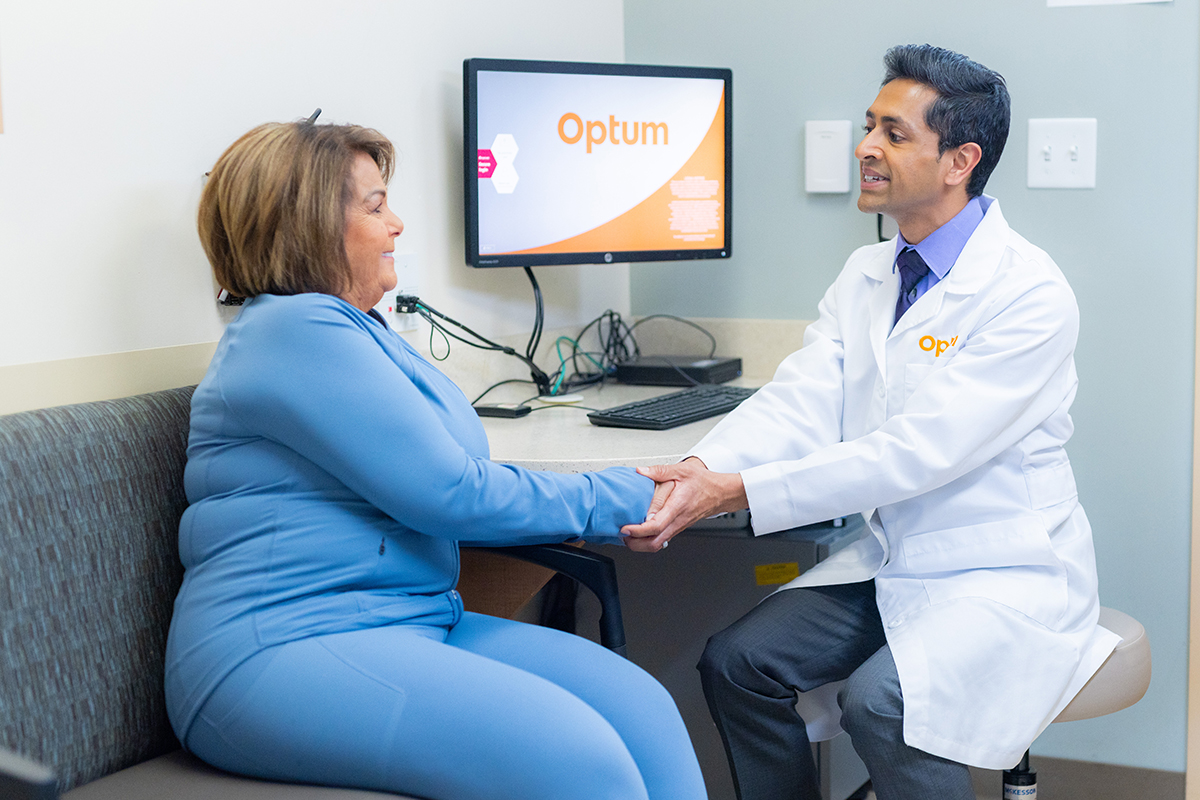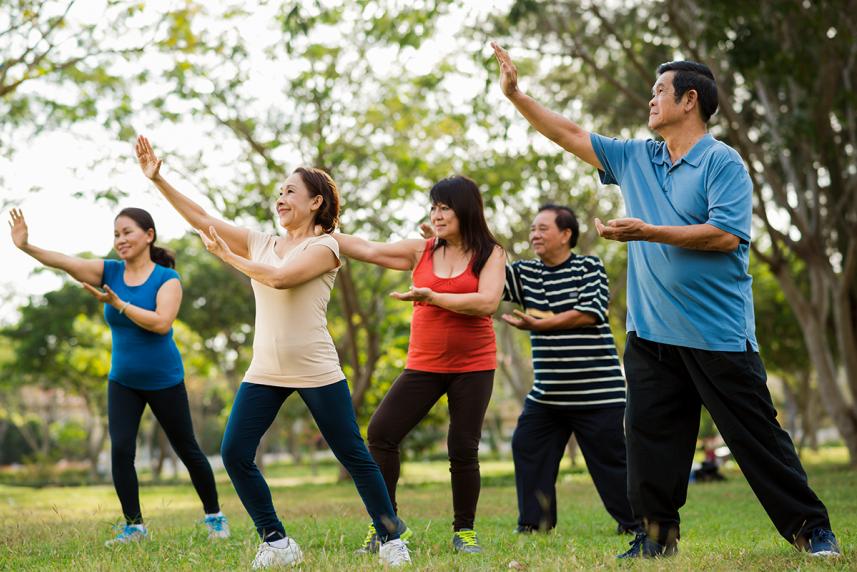
At Optum, you get personalized care to help you meet your health goals. That's why more than 4 million people trust our doctors and Medicare Advantage.

As you age, it’s important to keep your body moving and your bones strong. Here are some easy ways to do it.
Being active is a key way to help you stay healthy at any age. As you get older, whether you’re 40, 50, 60 or older, it’s especially important. The better you move, the more you can get out there and do the things you love to do.
A lot of that has to do with your ability to stay flexible and mobile, says Billy Ryan, a Chicago-based certified health coach at Rally.
When you improve your flexibility, you’re able to move and walk around more easily.1, 2 That can help you reach for something on a high shelf in your kitchen, throw a ball with your grandchild, or go on a hike.
Being flexible and able to move can also improve your balance and reduce your risk of falling. And that’s really important, because more than 25% of older adults fall each year.3 Falling once doubles your chances of falling again.3
Falls can have different levels of severity. For example, you could stumble while you’re gardening and land softly on the grass. But it could still leave you sore. Other falls could be more serious, like slipping in the bathroom and landing on a hard surface. Some falls can even be life-threatening.4 That’s why it’s important to talk to your doctor, no matter what kind of fall you have.
So, what can you do to better stay on your feet? Here are seven easy exercises you can try adding to your weekly fitness routine. But before you get going, it’s a good idea to consult your doctor. They’ll be able to tell you what moves are right for you, based on your health.

At Optum, you get personalized care to help you meet your health goals. That's why more than 4 million people trust our doctors and Medicare Advantage.
Yoga is low-impact and easy on your joints. But it also can help you move better as you age.5
This ancient practice involves moving your body into physical poses or postures, called asanas.6 Moving through yoga poses can help improve your abdominal strength and flexibility, as well as target specific muscles, depending on the pose.
Yoga also improves strength and balance, says Heather Wilson. She specializes in health innovation strategy at the YMCA of Central New York. Plus, it may help reduce stress. That’s because meditation and breathwork are also key aspects of yoga.
There are 84 classic asanas used in yoga.7 But the practice is easy to modify and can even be done while sitting in a chair.
You can join a local yoga class and learn from your instructor and peers. Or you can find a comfortable space in your home and practice yoga solo. There are plenty of beginner yoga tutorial videos online.
Wilson recommends doing yoga or chair yoga two to three times a week.
Tai chi is an ancient martial art that uses slow and controlled movements. It’s low impact and can even help you control your breathing and make you feel calmer.8
“Tai chi is a great practice for balance and coordination, which improves mobility,” says Ryan.
Like yoga, tai chi has many different postures. You’ll move your body through them in a slow, rhythmic way.9 You can learn tai chi from a local class or by watching beginner videos online.
Aside from making things easier on your joints, tai chi also increases:8
And it can even be a potential lifesaver: In a 2017 study, at-risk adults and older adults who practiced tai chi cut their risk of injury-related falls in half.10
Start by doing tai chi once a week, says Ryan. “Make it a habit before increasing,” he says.
When you climb stairs or go for a run, there are moments when you only have one foot on the ground. Having solid mobility on one leg at a time can help you stay on your feet.
Ryan suggests these easy exercises to improve single-leg balance.
Lunges:12
Standing on one leg:13
Heel-to-toe walking:13
These exercises can help you avoid falling, too, Ryan says. To get the most out of them, he suggests doing these exercises every day. “This can be done first thing in the morning or prior to bed as part of a healthy routine,” he says.
This exercise can help improve your stability and coordination, says Wilson. That’ll help you stay upright and reduce the risk of injury. “It also supports the natural alignment of your body,” she says.
Here’s how to do a standing back leg raise, says Wilson:
Wilson recommends doing standing leg raises at least three days a week. But you can also do them every day.
Get health tips you can trust delivered straight to your inbox. Sign up for our health and wellness newsletter today.
Walking is a great low-impact exercise that will get your heart pumping and joints moving. This is good news, since about 1 in 4 Americans sit for eight or more hours a day.14
Walking gets your whole body moving. But, specifically, walking is good for your hips and knees, says Ryan. He suggests that older adults consider taking a daily walk. (When the weather’s warmer, it’s a great reason to get outdoors.)
In fact, the CDC recommends that adults ages 65 and older get at least 150 minutes of moderate-intensity exercise a week. For example, 30 minutes of brisk walking five days a week.15
“Getting up to walk for 5 to 10 minutes every hour is a great place to start,” says Ryan.
(Learn some more easy body-weight exercises you can do at home.)
This type of exercise works your entire leg and your core muscles. When your muscles are strong and flexible, your joints will be able to move through their full range of motion.
Here’s how to do a step-up:16
Try doing this twice a week.
Push-ups are a great way to work your core and arm muscles. “Muscles we use for push-ups help us move better, carry things or push ourselves up from the floor or a chair,” says Wilson.
Here’s how to do a push-up:17
If you can’t get down on the floor, you can do push-ups against a wall or your kitchen counter. “Wall push-ups decrease the load on your upper body, due to the modified version of the exercise,” says Wilson.
Wilson suggests doing push-ups 2 to 3 times a week.
Bottom line: Getting older doesn’t mean parking yourself on a couch more hours of the day. In fact, it’s even more important to stay active. What better time to get moving than in the summer?
Sources
© 2024 Optum, Inc. All rights reserved. Do not reproduce, transmit or modify any information or content on this website in any form or by any means without the express written permission of Optum.
The information featured in this site is general in nature. The site provides health information designed to complement your personal health management. It does not provide medical advice or health services and is not meant to replace professional advice or imply coverage of specific clinical services or products. The inclusion of links to other web sites does not imply any endorsement of the material on such websites.
Consult your doctor prior to beginning an exercise program or making changes to your lifestyle or health care routine.
Stock photo. Posed by model.